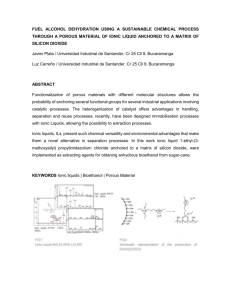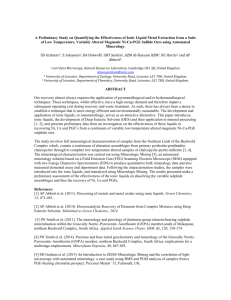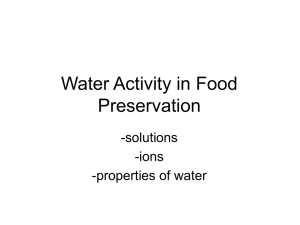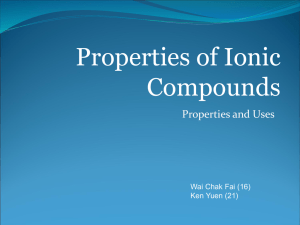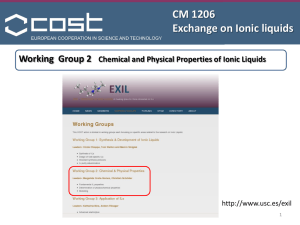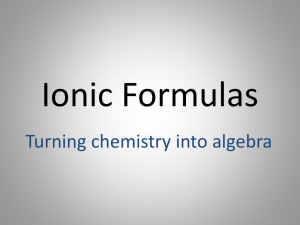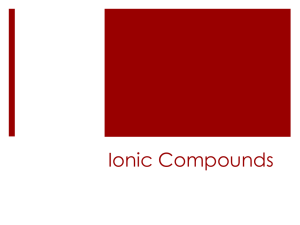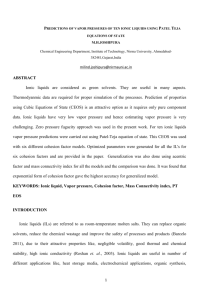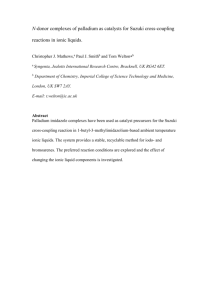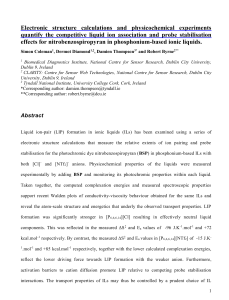Ionic Liquids
advertisement
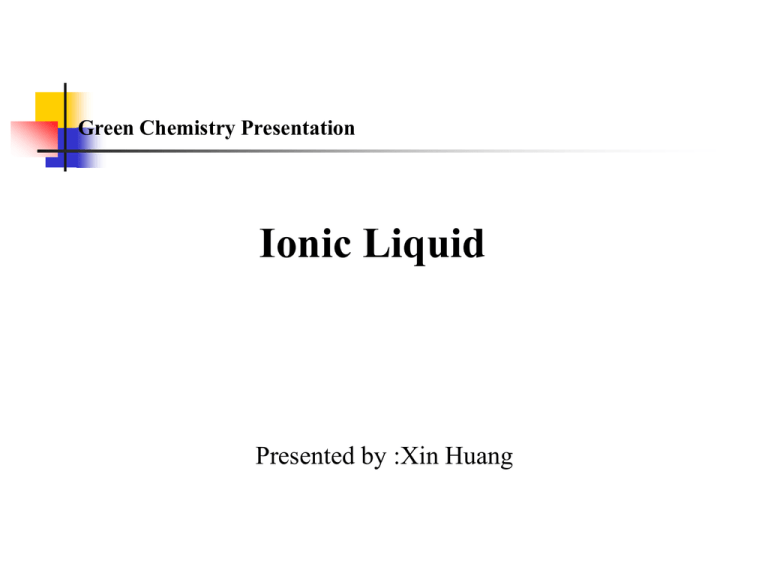
Green Chemistry Presentation Ionic Liquid Presented by :Xin Huang Development 2003 Year 2001 1999 1997 1995 0 200 400 600 No of publications 800 1000 Outline Definition Advantage Applications Ionic liquid in synthesis Examples Conclusion What are Ionic Liquids Common Definition Ionic Liquids (ILs) is the generic term for a class of materials, consisting entirely of ions and being liquid below 100°C. If they are liquid at room temperature, we call them room temperature ionic liquids (RTILs). Typical Cation and Anion Typical IL Cations R1 R2 N N N R * [PF6]- for moisture stable, water immiscible IL * [BF4]- for moisture stable, but water miscible IL * [AlCl4-] (or other Lewis acids) decomposes in water Discovery and History Paul Walden * The description of a low melting point salt 1914 * The first room temperature ionic liquid 1951 N-ethylpyridinium bromide- aluminium chloride melt * The most stable and conductive salts 1982 Ethyl ammonium nitrate 1,3-dialkylimidazolium salts * The hydrophobic ionic liquids 1992 1-ethyl-3-methylimidazolium tetrafluoroborate Advantage Easy separation Very low vapor pressure Non-flammable substance High thermally stable High mechanically stable Electrochemically stable Low toxicity Non-volatility Application Comparison of organic solvents with ionic liquids Plechkova, N. V.; Seddon K. R. Chem. Soc. Rev. 2008, 37, 123–150 Ionic Liquids in Organic Synthesis Catalytic Friedel–Crafts Hydrogenetions Alkoxycarbonylation Hydroformylations Heck reactions Olefin dimerization Diels-Alder Suzuki coupling Stille Coupling Oxidations Diels-Alder reaction Heck Reaction Wittig reaction Suzuki-Miyaura coupling reaction Stille reaction Friedel-Crafts reaction Hydrogenation Fluorination 12 principles of Green Chemistry 1. Waste Prevention 2. Atom Economy 3. Less Hazardous Chemical Process 4. Designing Safer Chemicals 5. Safer Solvents and Auxiliaries 6. Energy Efficiency 7. Renewable Feedstocks 8. Reduce Derivatives 9. Catalysis 10. Design for Degradation 11. Real-time Analysis for Pollution Prevention 12. Safer Chemistry for Accident Prevention Journal of Fluorine Chemistry A novel pyrrolidinium ionic liquid with 1,1,2,2 tetrafluoro 2 (1,1,2,2-tetrafluoroethoxy) ethanesulfonate anion as a recyclable reaction medium and efficient catalyst for Friedel–Crafts alkylations of indoles with nitroalkenes Jin-Hong Lin, Cheng-Pan Zhang, Zhi-Qiang Zhu, Qing-Yun Chen, JiChang Xiao * Preparation of pyrrolidinium salts Reaction Flow chart HNO3 65~68% 60℃, stirred overnight + N H H2O washed with diethyl ether 50ml*3 r.t. concentrated yellow solid + CH 3OH H N -O + filtration filtrate concentrated stirred, 12h H(CF2) 4O(CF2) 2SO3Na/MeOH r.t. N+ O pale yellow liquid AlCl3 50℃, stirred extracted toluene (3 ml*3) upper-layer concentrated purified TM. (flash chromatography) Green Aspects The yeild for preparing Ionic liquid is as high 99%. (Principle 2) Seperation of Ionic liquid is easy , just by filtration. Reaction condition is mild .(Principle 12) No byproducts in the preparation .(Principle 8) Green Aspects The high concentration of highly acidic species that can be immobilized in ionic liquids and that leads to a highly reactive catalytic phase allowing for fast reactions under mild conditions. In fact, acidic ionic liquids catalyze all reactions that are conventionally catalyzed by AlCl3, but without suffering the disadvantage of the low solubility of AlCl3 in many solvents. (Principle #3,5,9) The liquid nature of the catalytic phase eliminates the heat and mass transfer problems frequently encountered with heterogeneous Friedel– Crafts-catalysts and make the reaction get high yield .(Principle 2) The miscibility gap of most ionic liquids with alkylated aromatics allows for product isolation by simple decantation.(Principle #1,7) Green Aspects Ionic liquid also act as solvent in this reaction ,it prevents the waste of solvent. (Principle 1) Ionic liquid can be used directly for the next run after removing the solvent. Principle 7 Conclusion Ionic liquids ,as the new materials of multifunction , are widely used in various of fields. Environmently-friendly reaction process have vigorously been studied from the standpoint of green chemistry and based on the properities of easy separation , low toxicity , selective miscibility , ILS play an important role in organic synthesis as the green alternative solvent. Withe the development of multifunctional ILS , we can expect IlS would apply in more fields .

